Associated Builders and Contractors has released an artificial intelligence (AI) technology guide for the U.S. construction industry. AI in Construction — What Does It Mean for Our Contractors? outlines definitions, construction use cases, and considerations for the implementation of AI in construction.
“The purpose of the guide is to provide a level of knowledge to ensure contractors can be active participants in the construction AI conversation,” according to Associated Builders and Contractors.
The guide describes uses of AI during the construction project lifecycle, including preconstruction, construction, and building maintenance. It also provides definitions of terms such as deep learning and predictive AI, as well as best practices in drafting office AI policies.
“The possibilities of AI technology may sound endless, but we must first educate ourselves on the basics, and this resource is a starting point to understand AI and its potential impact on the construction industry,” said Patrick Scarpati, ABC Director of Construction Technology and Innovation. “The industry has immense opportunities to evaluate how we can better deliver projects, and we can lean on AI in achieving essential goals like upskilling, workforce development, knowledge transfer, supply chain optimization, enhanced safety design and planning, and much more.”
Use cases for AI in construction
The guide offers more than 20 uses cases and project management impacts across preconstruction, construction, and building maintenance, including:
Predictive Analytics: Analyze historical project data and current conditions to optimize construction schedules, resource allocation and task sequencing.
Supply Chain: Throughout the procurement process for self-performing contractors, artificial intelligence will empower the purchasing team to quickly identify availability and best pricing within a certain region.
Contract Review: Empower legal teams to quickly identify critical risk factors in construction contracts
Computer Vision/Intelligent Site Monitoring: Increase safety and security on jobsites. Through machine learning, video footage is trained to detect things like the number of workers entering/exiting the jobsite, workers in proximity of heavy construction machinery and even safety violations, such as the lack of face protection while saw-cutting concrete
Energy Management: Analyze energy usage patterns and optimize HVAC systems to reduce energy consumption and overall costs
Predictive Maintenance: Through the expanded use of building automation and control networks, AI can predict when building equipment is likely to fail, allowing for a proactive response.
According to ABC, “This resource is meant to act as a starting point in your journey to understand AI and its potential impact on the construction industry. By reading through definitions, construction use cases and considerations, the reader should walk away with a level of knowledge to ensure they can actively participate in future conversations on AI in construction.”
Related Stories
AEC Tech | May 1, 2023
Utilizing computer vision, AI technology for visual jobsite tasks
Burns & McDonnell breaks down three ways computer vision can effectively assist workers on the job site, from project progress to safety measures.
AEC Tech Innovation | Apr 27, 2023
Does your firm use ChatGPT?
Is your firm having success utilizing ChatGPT (or other AI chat tools) on your building projects or as part of your business operations? If so, we want to hear from you.
Design Innovation Report | Apr 19, 2023
HDR uses artificial intelligence tools to help design a vital health clinic in India
Architects from HDR worked pro bono with iKure, a technology-centric healthcare provider, to build a healthcare clinic in rural India.
Resiliency | Apr 18, 2023
AI-simulated hurricanes could aid in designing more resilient buildings
Researchers at the National Institute of Standards and Technology (NIST) have devised a new method of digitally simulating hurricanes in an effort to create more resilient buildings. A recent study asserts that the simulations can accurately represent the trajectory and wind speeds of a collection of actual storms.
3D Printing | Apr 11, 2023
University of Michigan’s DART Laboratory unveils Shell Wall—a concrete wall that’s lightweight and freeform 3D printed
The University of Michigan’s DART Laboratory has unveiled a new product called Shell Wall—which the organization describes as the first lightweight, freeform 3D printed and structurally reinforced concrete wall. The innovative product leverages DART Laboratory’s research and development on the use of 3D-printing technology to build structures that require less concrete.
Smart Buildings | Apr 7, 2023
Carnegie Mellon University's research on advanced building sensors provokes heated controversy
A research project to test next-generation building sensors at Carnegie Mellon University provoked intense debate over the privacy implications of widespread deployment of the devices in a new 90,000-sf building. The light-switch-size devices, capable of measuring 12 types of data including motion and sound, were mounted in more than 300 locations throughout the building.
Architects | Apr 6, 2023
New tool from Perkins&Will will make public health data more accessible to designers and architects
Called PRECEDE, the dashboard is an open-source tool developed by Perkins&Will that draws on federal data to identify and assess community health priorities within the U.S. by location. The firm was recently awarded a $30,000 ASID Foundation Grant to enhance the tool.
AEC Tech | Mar 14, 2023
Skanska tests robots to keep construction sites clean
What if we could increase consistency and efficiency with housekeeping by automating this process with a robot? Introducing: Spot.
Modular Building | Mar 3, 2023
Pallet Shelter is fighting homelessness, one person and modular pod at a time
Everett, Wash.-based Pallet Inc. helped the City of Burlington, Vt., turn a municipal parking lot into an emergency shelter community, complete with 30 modular “sleeping cabins” for the homeless.
AEC Tech | Jan 27, 2023
Epic Games' latest foray into the AEC market and real estate industry
From architecture to real estate, the realm of computer-aided design hits new heights as more and more firms utilize the power of Epic Games’ Twinmotion and Unreal Engine.

















